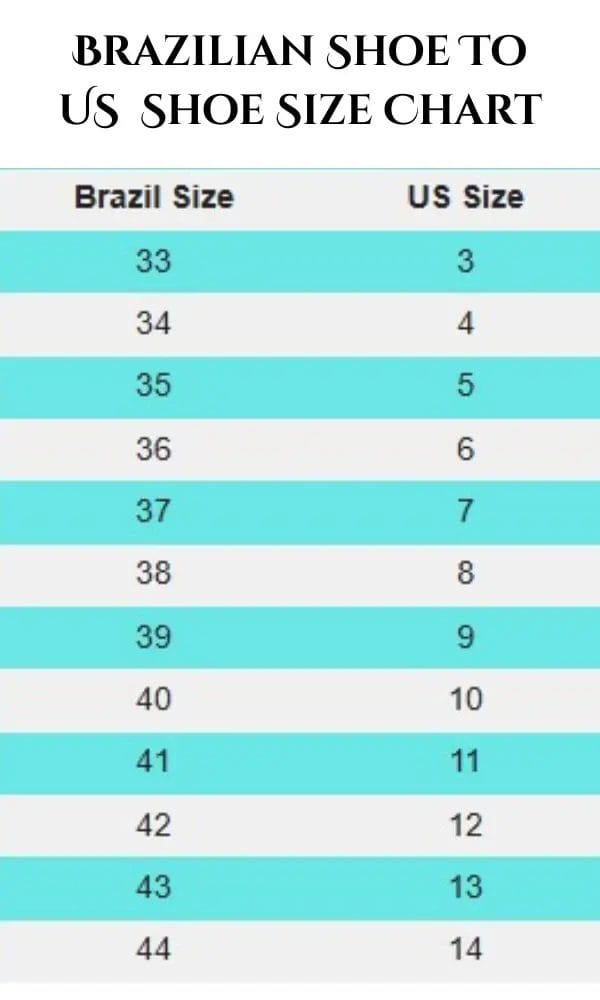When shopping for shoes in Brazil or Brazilian brands, it’s important to understand their unique sizing system. Brazilian shoe sizes differ from US, UK, and European sizes. Knowing these differences helps international shoppers and tourists find the right fit. Misunderstanding sizes can lead to discomfort and unnecessary returns.
Brazilian Shoe Size Chart
| US Men’s | US Women’s | UK | EUROPE | BRAZIL | CENTIMETER |
|---|---|---|---|---|---|
| 8 | 9.5 | 7 | 41 | 39.5 | 26 |
| 8.5 | 10 | 7.5 | 42 | 40 | 26.5 |
| 9 | 10.5 | 8 | 42.5 | 40.5 | 27 |
| 9.5 | 8.5 | 43 | 41 | 27.5 | |
| 10 | 9 | 44 | 42 | 28 | |
| 10.5 | 9.5 | 44.5 | 42.5 | 28.5 | |
| 11 | 10 | 45 | 43 | 29 | |
| 11.5 | 10.5 | 45.5 | 43.5 | 29.5 | |
| 12 | 11 | 46 | 44 | 30 | |
| 13 | 12 | 47.5 | 46 | 31 |
Brazil Shoe Size to US
| Brazil Size | US Size |
|---|---|
| 33 | 3 |
| 34 | 4 |
| 35 | 5 |
| 36 | 6 |
| 37 | 7 |
| 38 | 8 |
| 39 | 9 |
| 40 | 10 |
| 41 | 11 |
| 42 | 12 |
| 43 | 13 |
| 44 | 14 |
Understanding Brazilian Shoe Sizing
Brazilian shoe sizes are measured differently from other regions like the US and Europe, with key differences that can affect your comfort and fit. Unlike the US or UK, Brazil’s shoe sizing focuses primarily on the length of the foot in centimeters. This system may feel more precise but can be tricky when converting sizes across regions. For example, a Brazilian size 38 doesn’t correspond directly to a US or EU size.
Balancing these size differences requires understanding the tradeoff between length and width. Brazilian shoes often prioritize foot length, but they may not account for wider or narrower feet, making fit a challenge. You’ll need to measure both dimensions carefully to avoid discomfort or incorrect sizing.
Making the right choice in Brazilian shoes means considering the unique sizing method and its impact on your overall shoe comfort. Misjudging these measurements could lead to shoes that are too tight or too loose, affecting your experience.

How to Measure Your Feet for Brazilian Shoes
Accurately measuring your feet is crucial to ensure the Brazilian shoes you buy will provide the best fit. To start, you’ll need a ruler, a piece of paper, and a pencil. First, place your foot on the paper and trace around it, keeping the pencil upright for an accurate outline. Next, measure the length from the heel to the longest toe and record it. Then, measure the widest part of your foot for width.
However, balancing length and width can be tricky, especially since Brazilian shoe sizes focus more on length. You might find shoes that fit perfectly in length but are too tight in width. To avoid this, double-check both dimensions before making a purchase.
Common mistakes, such as measuring in the morning when feet are smaller or not keeping the pencil straight, can lead to incorrect sizing. Measuring both feet is also essential, as one foot is often slightly larger. These steps will help you choose the right size and avoid discomfort or returns.
Factors to Consider When Buying Brazilian Shoes
Beyond just size, there are several important factors to consider when choosing Brazilian shoes. First, shoe material plays a significant role in fit and comfort. For instance, leather shoes often stretch and mold to your feet over time, while synthetic materials may not adjust as readily.
Additionally, different brands can have unique sizing quirks. One brand’s size 38 may not fit the same as another’s due to variations in their sizing charts or manufacturing processes. This discrepancy means you may need to try multiple brands to find the best fit.
Seasonal styles also impact sizing. For example, summer sandals often have more adjustable straps than winter boots, which might affect how snugly the shoes fit. Balancing these factors involves considering both the shoe material and brand sizing while being mindful of seasonal variations.
By addressing these considerations, you can make a more informed decision and choose Brazilian shoes that not only fit well but also suit your comfort and style needs.
FAQ
1. How do I convert Brazilian shoe sizes to my local size?
To convert Brazilian shoe sizes to your local size, refer to a conversion chart that compares Brazilian sizes to US, UK, and EU sizes. For example, a Brazilian size 38 usually corresponds to a US size 7 or an EU size 38.5. Always check the specific chart provided by the shoe brand, as conversions can vary slightly.
2. What should I do if my feet are different sizes?
If your feet are different sizes, measure both feet and use the larger size when buying shoes. Many brands offer adjustable features or sizes that accommodate slightly larger feet. Always try on shoes or check the return policy to ensure you can exchange them if they don’t fit perfectly.
3. How can I ensure a good fit when buying Brazilian shoes online?
When buying Brazilian shoes online, measure your feet accurately and refer to the brand’s specific size chart. Check customer reviews for insights on fit and sizing quirks. Additionally, ensure the store offers a flexible return or exchange policy in case the shoes don’t fit as expected.